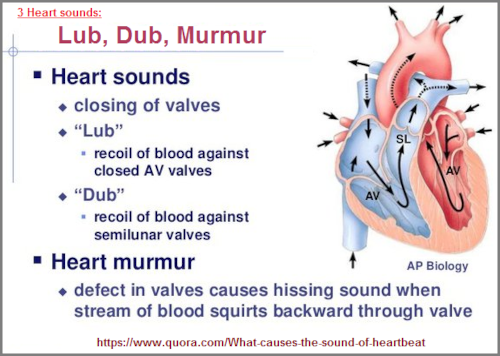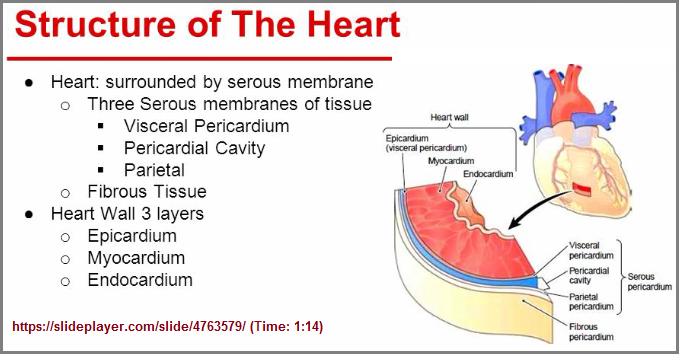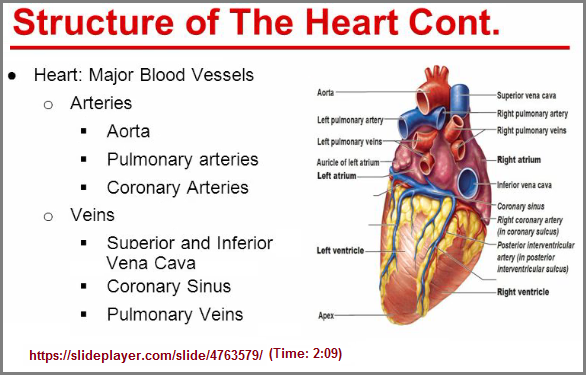page 22
~ The Study of Threes ~
http://threesology.org
| Hybrids page 1 | Hybrids page 2 | Hybrids page 3 | Hybrids page 4 | Hybrids page 5 |
| Hybrids page 6 | Hybrids page 7 | Hybrids page 8 | Hybrids page 9 | Hybrids page 10 |
| Hybrids page 11 | Hybrids page 12 Playmate God |
Hybrids 13 Economics 1 |
Hybrids 14 Economics 2 |
Hybrids 15 Economics 3 |
| Hybrids 16 Economics 4 |
Hybrids 17 Economics 5 |
Hybrids 18 Economics 6 |
Hybrids 19 Economics 7 |
Hybrids 20 Language 1 |
| Hybrids 21 Language 2 |
Hybrids 22 Language 3 |
Hybrids 23 Language 4 |
Hybrids 24 Physics |
Hybrids 25 |
| Hybrids 26 | Hybrid 27 |
Visitors as of 30th July, 2021

When thinking about the origin of speech one might also think about the origin when humans recorded a conscious acknowledgement of word usage as opposed to merely taking it for granted that vocal utterances were references one reacted or responded to, and yet never actually made an effort to make some record of having developed a perception recognizing the usage of speech as a tool of communication. Whereas I don't know if the biblical reference of John 1:1 is the first or only description, it nonetheless helps the reader to understand a period and place in time when a conscious acknowledgement of "Language as a tool" was made: "In the beginning was the word, the word was with God and the word was a god." If you remove the statement from its religious orientation and place it into the context of being a reference to a developing consciousness which began to view language as having much greater meaning and importance than ordinary, everyday utterances; it makes some sense to understand the writer or writer's of the comment as having an observational ability which may or may not have been an unusual characteristic except for the act of also recording such an observation about language.
A simplified portrait of how speech is made can be illustrated, along with a very curious recurring pattern of patterns affecting the heart, lungs and mind:
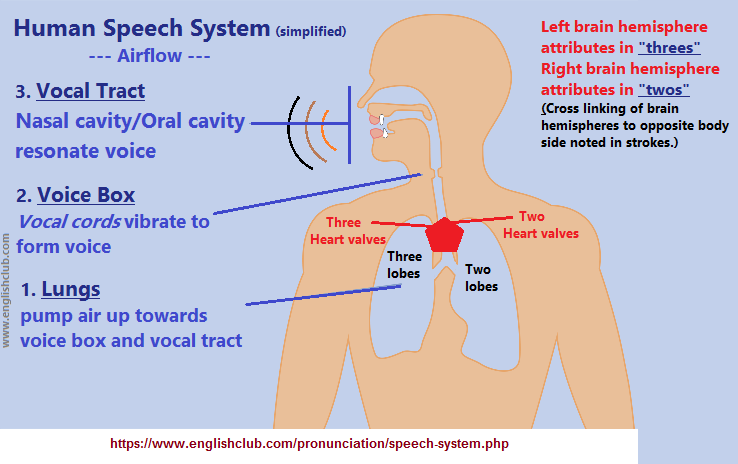
Language has developed into a Big deal as noted by its usage in poetry, speeches, sermons, singing, and the multiple written forms in use today. If one can imagine how one or more vocal utterances came to be used repetitively and that such a repetition had some singularly focused general application, it is easy to understand how a person's voice which came to utter sounds in a manner with a difference, caught and kept everyone's attention. Since the desert communities in which the concept of a single god arose was a place where people were vying for socio-political power (the words "Monotheism" and "government" as well as "religion and theology" came later); a person's voice could hold great sway on the public. If a person's vocal quality lacked the aptitude for turning heads and holding attention, then signifying particular words and/or phrases and/or ideas could serve the same or a greater purpose. It's easy to see how words could be described as a god and/or be associated with a god, particularly in a social setting where there was a wide-spread obsession with the concept of a god.
If you removed the obsession and stript away all religious connotations and denotations, what we have is a reference to a conscious acknowledgment of language being used as both a tool and weapon. Yet, if you strip away all attributes of a social context from the reference, you might be able to persuade some readers to view the phrase: "In the beginning was the word, the word was with God and the word was a god" in different ways by substituting the word "god" with different entities. For example:
- In the beginning was the word, the word was with the Sun and the word was Enlightenment... then a Sun god... then the (risen) Son of a god.
- In the beginning was the word, the word was with the Moon and the word was a Moon Goddess... then Matriarch... then Mother Earth... then Mother land.
- In the beginning was the word, the word was with Crops and the word was a Farmer.
- In the beginning was the word, the word was with Nature and the word was Natural events... then gods speaking, then 'god-language' interpreters.
- In the beginning was the word, the word was with Stars and the word was an Astrologer... then Astronomer
- In the beginning was the word, the word was with Magic and the word was a Magi.
- In the beginning was the word, the word was with Swords and the word was a Blacksmith or Metallurgist. (Such as in the case of King Arthur whose knowledge of metallurgy helped him "pull" the sword from raw ore.)
- In the beginning was the word, the word was with Geometry and the word was a Geomancer... then Geometer.
- In the beginning was the word, the word was with Pain and Suffering and the word was a Prognosticator... then religious herbalist, healer, now Physician.
- In the beginning was the word, the word was with trading and the word was a trader, then Merchant... now stock broker.
- In the beginning was the word, the word was with intoxicated or dervish Gibberish and the word was a Seer.
- In the beginning was the word, the word was with Superstition and the word was a patrolling Soldier... then Sheriff... now Police officer.
- In the beginning was the word, the word was with change and the word was a Life form... now called Evolution.
- In the beginning was the word, the word was with Numbers and the word was a Numerologist... now Mathematician.
- In the beginning was the word, the word was with Playfulness and the word was a Trickster... then Strategist... now Gamer.
- In the beginning was the word, the word was with Crops and the word was a Farmer.
- In the beginning was the word, the word was with animals and the word was an Enslaver... then Owner... then Animal Husbandry (Domesticator).
- In the beginning was the word, the word was with Grain and the word was a Beer Brewer.
- In the beginning was the word, the word was with Musical Spheres and the word was a Metaphysician.
- In the beginning was the word, the word was with Cling and Klang associations and the word was a Poet.
- In the beginning was the word, the word was with Sports and the word was a Coach.
- In the beginning was the word, the word was with Learning and the word was a Teacher.
- In the beginning was the word, the word was with Mom and Dad and the word was a Parental-god.
- In the beginning was the word, the word was with Rulers and the word was a god-King.
- In the beginning was the word, the word was with Language and the word was a Linguist.
- In the beginning was the word, the word was with Law and the word was a Lawyer or Politician. (as it is today though Journalists attempt to undermine, overthrow or otherwise become some significant "word" so as to receive a Pulitzer Prize, etc...)
- ETC...
Multiple hybrids of the foregoing phrase can be recorded, though most simply take on the garments of different applications and practices. While those in the different professions might well take time to develop some knowledge of an originating source for their domain of interest such as from Astrology to Astronomy or Alchemy to Chemistry and philosophy to teaching and physics or from herbalist to pharmacist as well as other genres of exploring alternative ideas subjected to one or another model of investigation; including the occasion reversal of orientation whereby some ancient craft is taken up because it suits the mentality of those who expose themselves in such a way that they communicate their wares to others who are persuaded into believing that some old way embraces something more real, more true, more natural than a particular profession of today. However, the point is that all professions can find some moment in time which is relative to the development of a specialized vernacular used in their field of interest and how it came to be a "god-like presence" in the sense of being standardized such as in the case for using particular models and labels, like the wearing of a white coat or being a member of an association practicing a like-mindedness. In the beginning was some word and that word was identified with a particular application and that application's repetitive employment became the means by which a person became known, and by knowing them one might be more easily persuaded by them in such a way as to provide them with a means to further their interest. The idea of a god and "THE" god became entrenched by a given type and formula of words being used in given contexts for given discussions.
And so it goes, because of the different experiences encountered, it is easier to be right about a perception by speaking in generalities about specificities, than specific generalities, even if the latter case is just as true if one breeds the same for an inclusion.
Language. Ah yes, language. From the babbling of a brook into streams of thought from which we are provides an ocean of knowledge. With secret words, into an uncompleted tower of Babel from which incantations spill forth in an attempt to conjure up that thought to be summoned to do our bidding for good or evil. Thus too do we envision language in the frame of a personal name that when known provides us with power over someone; as an idea summarized in the story of Rumplestiltskin. Whereby if not by an incantated phrase then the repetition of a single word is sometimes used to set the stage for a desired scenery that is often vaguely described with attendant beliefs associated with an indulged mood such as in the case of a Mantra, for which the two-lettered "Om" can be referenced as a condensed representation of the three letters AUM.
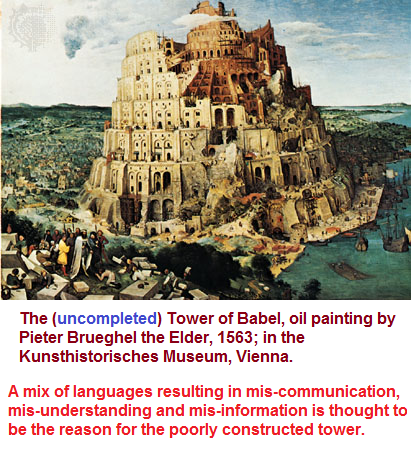 |
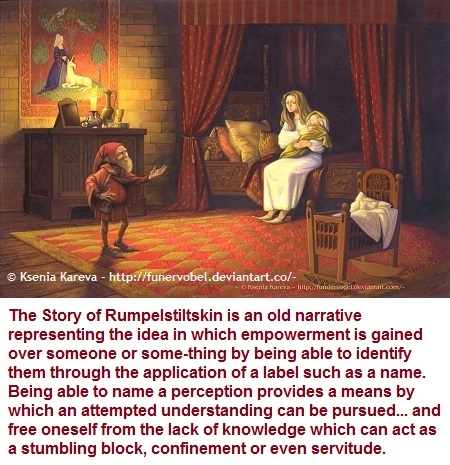 |
Standard Cognitive model page 3
Every profession likes to have its own vocabulary, and special phrases much in the manner of a secret code that it may claim is not secret, but is nonetheless used by a few to create a group who dominate a given field of study and practice. One establishes a "name" for themselves and hence a special label. Whereas at one time to know one's name was the beginning of having some prospective power over them or be attached to or associated with a power figure; it is customary for the three-patterned phrase "What's your name?" or "What's their name?" to be used as a dissecting tool. Uncovering one's real name, despite the attempts by some to use an alternate I.D. (identification), is summarized in the old story of Rumpelstilskin. Instead of one's individual name having some level of power, it is often the case for someone to have an I.D. tag or card as a substitute (word) power reference. Prisoners in prisons have their power words just as do police officers and soldiers. The word "Authority" has power in some instances as do various titles. In some instances the titles used in one genre of study is taken up by another profession as if to inculcate some level of similar importance and thus some similitude of power. Take for example the usage of the word "sprit" generally used in the field of religious studies, though incorporated into the ideas about law and metaphysics. By using the expression "The Spirit of the Law as opposed to the Rule of Law", the intimation that Law somehow has a spiritual essence side to it, necessarily causes some to overlook the presence of a dichotomous orientation being used in the discussion of law, though it is well-known for its legal doublets. Law does not heighten its attempted significance as some purported philosophy into a potentially far-reaching metaphysics by such an adoption.
At one time having a "Press" card enabled one to have special privileges as well as the idea of revealing information to the Press for something to become public knowledge, though such items today have much less respect and believability are representing some sort of power. The same goes for science and Scientists or Math and Mathematician. Whereas the word "teacher" garners more respect in some countries than others, it too is a power word, just like money, crazy, and some slang words... though vulgar expressions are not as powerful as many think to use them as such. However, when words alone do not provide some real or imagined power for the purpose of control (i.e. "God is going to punish you"), or the purpose of inflicting pain or injury ("I curse you"), or providing comfort ("I understand"), or providing support ("I Used to feel as you do"); then one may turn to the usage of "speaking" or "making a statement" by wearing particular clothes, more (or less) jewelry, or use jewelry in a semi- self-mutilating way, or embed tattoos which embody some portion of a person deeper than just the outer portion of their skin... and are supported in their efforts to take up this language form, particularly when screen writers of motion pictures feature such costumes with characters who are particularly violent, been abused, ignorant, or are in some way immoral. It is not uncommon for a person to encounter a movie where none of the characters are appealing... nor their scripts or the music score.
The dimensions of language can take on many mediums. Be it the language of non-word symbolism such as Mathematics, Music, Photography, Architecture, Chemistry, Botany, etc.; such expressions nonetheless represent ideas which may also or could be translated into words. For example, if we use codes instead of words though the codes may well stand for letters of an alphabet from which words can be derived, we list might Morse code, Binary computer code, Braille, Semaphore (flag code used on ships), hand signals and dance routines. The latter example often with expressions whose repetitions are reminiscent of rhyme-ending poetry or some repeating stanza in a song. All of which equally represent different layouts of a basic cognitive structure of which language portrays a shadow, an echo, or some other hint thereof. Whereas some shadows, hints, and echoes are more forthcoming in the sense of being amenable to a reductive numerical association, others are a step away from simple language such as when ideas and phrases themselves conceal one's ability to "read between the lines" and achieve some semblematic recognition of an underlying pattern that socialization has frequently complicated and as well obscured.
Symbolism is one of the mediums used as a language. For example, when the word "God" does not cause a reflective stir, the use of a Cross or other emblem may take on a power role, just as does the garments of clergy and the idea that a person can create "Holy water." When a religion is confronted by a populace that does not interpret narrative- associated words such as Holy, God, Sacred, Peace, Love, Morality, Saviour, Apocalypse, Satan, etc., as having any particular value; it may produce the resulting image in a reader that the populace is one that practices some oppositional perspective or has been infected with a virus turning everyone into a Zombie. That is if such words are highly valued or are used as bargaining chips whenever one is confronted by a situation in which a knowledge and verbal usage thereof can be beneficial. But placing such an idea as an inclusion in the present discussion leads us far astray from the intent to speak of more basic issues with respect to language. Hence, let me get back on track by taking a momentary step backwards.
Note: it is sometimes necessary to repeat images from a preceding or another page from my journal because a given individual may come upon the present page by accident and thus are not aware that a given idea has been previously discussed. Let me provide an image on shadows used on the previous page:
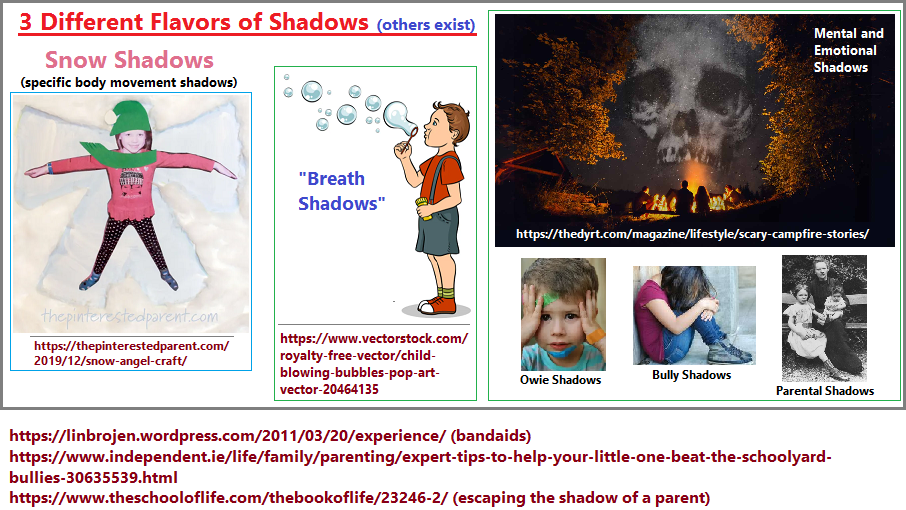
Echoes and shadows are similar phenomena, like different life forms reacting to the same situation in a way that is conducive to their ability to react. One might also include the identity of a phantom limb phenomena in this lineup of similarities as well as human skin or exoskeletons. Multiple others might well be included if one takes the time to peruse different phenomena from different lines of research in different subject areas. For example, math equations are "echoes" or shadows of one's thought processes which become manifest with numbers and symbols, yet remain vague to those not comprehending a particular equation and can only reference a math expression as an equation without being able to decipher the language in any intelligible way.
Like a supposed solid rock in a moving stream expresses itself by being carved out slowly by the moving water, a supposed solid tree bends as far as it can under the voice of a wind storm. Each item in its own way mimics that to which it is exposed to. The bending of a tree is an echo, is a shadow of the wind we cannot see. In such a sense a child is like a stone and tree. For example, one offers a "Yes or No" question to a child and the child says "No". By inverting the two alternatives in a "No and Yes" pattern, the child says "Yes". For example, we ask a child: "Do you want to play with a (certain) toy"... Yes or No? The child may well reply No. If we invert the latter portion of the question to a "No or Yes" sequence, the child may well reply Yes. It is an echo reply. Or if you prefer, the child is shadowing the last portion of a person's speech pattern. While some readers have already observed this for themselves, I made the discovery decades ago and relayed my perception to a young mother who could not believe what she was hearing. She honestly thought her child was making a choice and not merely mimicking the last word the child heard. How one hears and how one speaks are patterns of hybridization not necessarily considered together when one discusses speech or one discusses hearing. Far too many people are inclined to specialize.
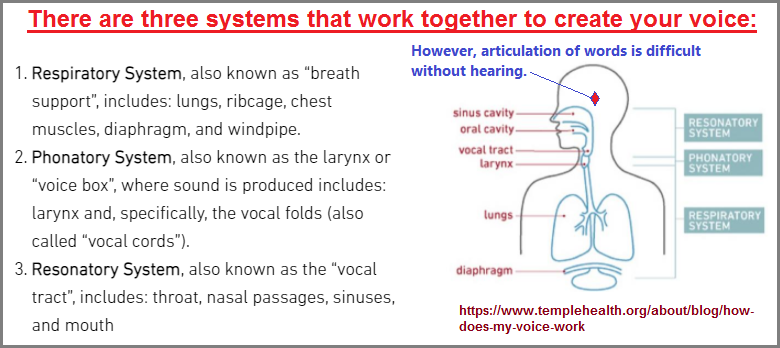
Enough can not be said for the effects of hearing on one's perceptions and responses such as by way of vocal utterances called speech, screams, or otherwise. Nor if a person views "hearing" in an analogical or metaphorical sense. For example, if I tell you that I can "hear" groups of three by way of my near-sightedness (or focus), you might think that I am confusing one type of perceptual ability with another. And If I mix and match the different senses by saying I think not in words but colors, you might think I am on some sort of drug or there is a misalignment in the structure of my brain, despite having had my brain subjected to an exam and having it found to be routinely normal, according to the CT scans. (Even though one friend of mind commented that although my brain may be normal my mind isn't. I jokingly told the technician taking the exam that I was hoping my brain showed three hemispheric portions (or some other extra-terrestrial anomaly) so as to account for my uncommon views. We both laughed.
While some readers may I am talking literally, others understand from reading different pages at this site readily realize that I am speaking metaphorically, though I did not know this at a very young age when such thoughts came to mind. When I told others about the uncontrolled exercise taking place in my mind and having no vocabulary nor knowledge with which to explain or defend myself, I was invariably viewed as someone to keep one's distance from... that is if they wanted to continue to learn the normal, the right, the correct way of thinking expected by peers, parents and professionals. The point in this excursion is to once again express the need for us to take a closer look at hearing in its relationship to language and that which has been established afterwards called grammar.
I also want to mention that even though we provide hearing tests to different people under different occasions and like to think that there is a typically normal range of hearing which occurs all the time, this however,... by personal experience, is not the case. Just as I have periods in which my visual acuity is surprisingly robust with colors, so too must I apply this circumstance to all the other senses. As such, I don't hear the same all the time. I believe thresholds of hearing can play out differently throughout the day or at given intervals. Whereby one's hearing acuity can be lowered or exceed some presumed human standard for brief or prolonged periods under given situations (without the usage of some intended drug stimulant or depressive)... like a person whose hearing may become more alert/acute in the absence of being able to see. In other words, there are compensations which can take place. But more to the point, the fact is we are enabled to achieve so-called standards which exceed the norm. In further words of an attempted elaboration, we have the capacity to enlarge the ability of one or another (or all) perceptual channels and may not necessarily need to lose the ability of some other perceptual channel. A person's body may routinely lesson or switch off one sensory channel, thus reflexively compensating for this by increasing the ability of some other perceptual sense. While some may want to name and number this a 6th, 7th, 8th, 9th, etc., sense, unless preferring to follow in the cognitive foot-steps of those using the three-word phrase of extra-sensory perception.
Because there are a noted array of "three" patterns in the human ear, I have claimed that this may well have influenced the occasion for various three patterns to be developed in linguistics and grammar. (Language 3s page 1) As a prospective experiment, we would need to construct an artificial ear with its conventional array of "three patterns" and firstly assume that what goes into it (the input) will necessarily create various patterns-of-three which, when translated by the brain, will create patterns of three in its expressions... or output. In other words, we need to establish some baseline for the equipment used in the experiment, even though we know this is an artificiality, since this will have an impact on the double-slit experiment used in physics as a means of declaring the existence of what has been labeled as a "wavicle" and described as the Wave–particle duality.
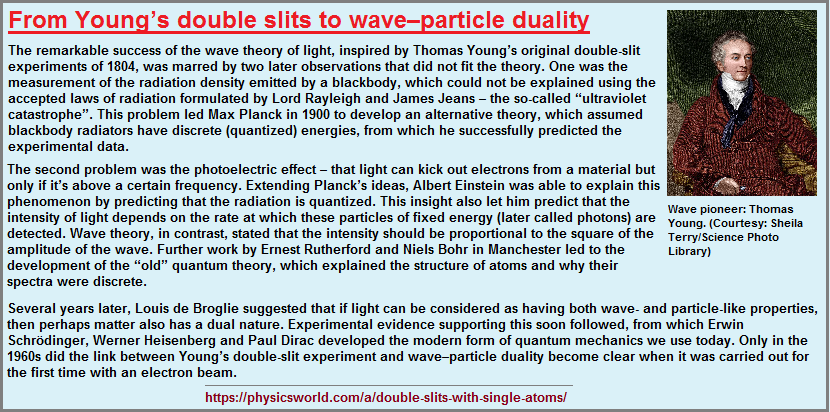
From my perspective, Mathematics is often used to uncover some perceived shadow lurking about in the periphery of researchers who attempt some modicum of representation which can provide a tangibility to not only grasp more decisively on, but provide more than just an idea that to others might well sound like a ghost story. It is not to say that some creative idea has no solidity to it, it's just that current types of conceptualization may not make use of the necessary vocabulary in the appropriate order or context by which another or others might be able to apprehend with a similar identification. It is well understood that the proverbial light bulb over one's head may not be seen by anyone else, much like a dream in which a distinct vividness occurs and yet no readily available camera or other copying device even exists. More to the point, it is often the case that a person has a light bulb over their head but those in their immediate circle of friends, family, neighbors, etc., are not even in-tune with the idea of the type of lightbulb a person is having illuminate for them. If I were to tell you that I have witnessed dreams in which it was like someone turned on a light switch or items in a dream became extraordinarily vivid; you might respond within the means of an explanation which has the greatest value for you such as either representing a negative or positive and supportive opportunity. Since I have tried to provide such tales of experiences and found no one to provide a response beyond the typical commonalities of reasoning, I prefer to write the ideas down because there will doubtless be someone at sometime who will be able to identify with the experience... unless of course they are truly original and not merely some creative juxtapositioning of ideas already in the grist mill of human considerations... whether published or not.
I can see words and expressions as being described as the imagery of shadows, echoes and inferential hints that we humans have historically compartmentalized by looking at a given issue in the same way and conducting experiments according to a two-patterned frame of orientation such as the double-slit experiment. With respect to words and writing, I recall long ago writing a poem in which I described "words of a feather flock together", as a playful alternative to the idea that "birds of a feather flock together". In both cases, a duality of orientation is being practiced. On another occasion I recalled the idea of Alchemists trying to transmutate gold out of lead and applied this to an observation about a group of would-be students in a poetry class using pencils to write with. (The use of computers was not a given in those days, so many decades ago.) Thus I wrote a short script concerning the students trying to produce poems of gold from their pencil lead. This too is an example of a socially distributed inclination to use dichotomization, though at the time I was not as consciously aware of it as I now am. The point I want to make is that a preference for patterns-of-two creation may well suggest that a pattern-of-three ear is not functioning optimally since the human larynx or overall voice box has a repeating two-patterned vocal cord structure, even though:
Interestingly, along with the "two pattern" of vocal cords, I came across a two-pattern idea concerning the larynx and the brain:
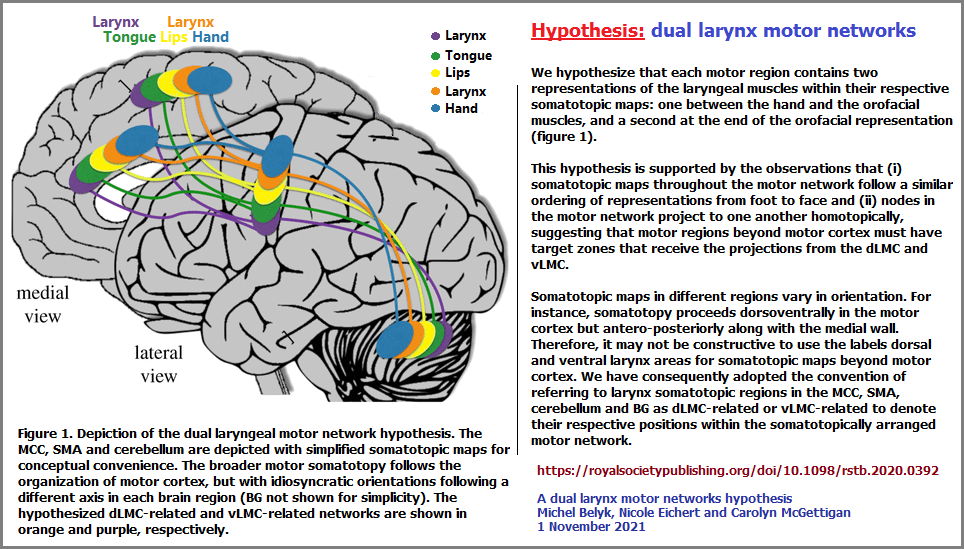
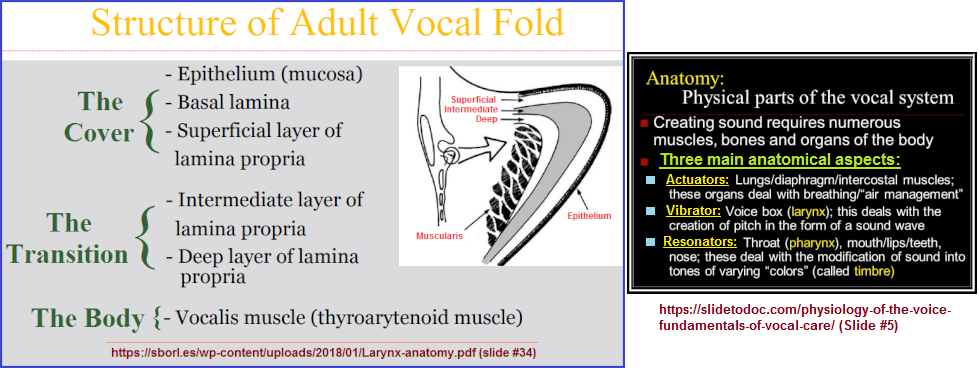
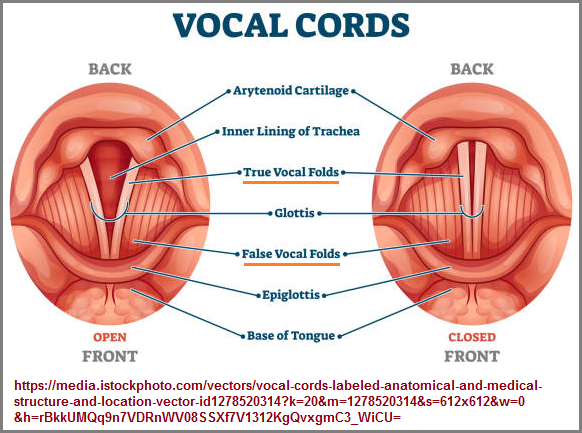
The cavity of the larynx extends from its triangle-shaped inlet, to the epiglottis, and to the circular outlet at the lower border of the cricoid cartilage, where it is continuous with the lumen of the trachea. (Larynx) (The windpipe is linear. Hence, we see a Linear- Circular- Triangular modeling. This three-patterned model needs to be reference not in isolation, but as a recurring phenomena: Linear, Circular, Triangular configurations page 1).
By artificially creating such a hearing and 'sounding-board' mechanism, we can thus alter the structure of the ear (into different component arrays of numerousity), such as replacing all pattern-of-three designs with a pattern of one, or two, etc., or mix and match pattern assemblies; in order to view what sort of pattern(s) come out. We may then find that the brain works in a characteristic numerically identifiable way(s) according to the sound vibration(s) one is subjected to, despite such references as loud, quiet, soft, hard, smooth, calming, etc... If altering the structure of the ear does not have an effect on the outcome of patterns, then we might want to assume that a recurring three-patterned structure on the ear has no real impact on how we view component structures of ideas used in linguistics and grammar.
This is an interesting engineering task that would be well worth a PhD. (while at the same time upsetting the double-slit experiment apple cart off of which so many researchers feed and align their work in accordance with.) Particularly since it would alter our conception of how we conceptualize. Let me first show the previously provided image of the ear with recurring three-patterned features, and then reference the brain with characteristic attributes, which are commonly described as inaccuracies. And yet, those striving to debunk the value of the idea about Right and Left Hemisphere attributes, overlook the underlying numerical referencing which is possible and can be further applied to at least two other physical structures (Lungs and heart). Whereas I am stressing the numerical pattern which can be derived by an assessment of presumed hemispherical attributes, detractors of the hemispherical lateralization distinctions are more concerned with trying to stress overlapping interactions. It is particularly interesting that we can view the Right hemisphere of the brain as representing ideas that have an identifiable pattern-of-two and the Left Hemisphere with patterns-of-three, and include that if one uses a Right hemisphere attribute to view the attributes of the Left hemisphere they will necessarily see pattern-of-two or engage in some dichotomy issuing forth some other value as a preferred oppositional; and then by using the Left hemisphere to analyze the attributes of the Right hemisphere we necessarily see patterns-of-three. While it is clear both sides can engage in transposing their dominant view on the other Hemisphere's attributes, the fact remains is that we can distinguish recurring patterns of distinction that are amenable to a numerical classification scheme.
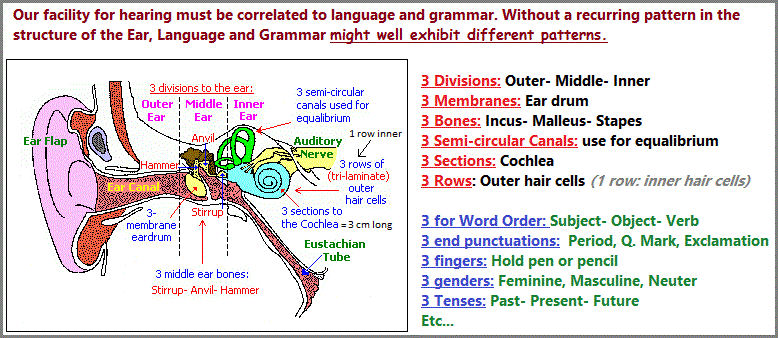
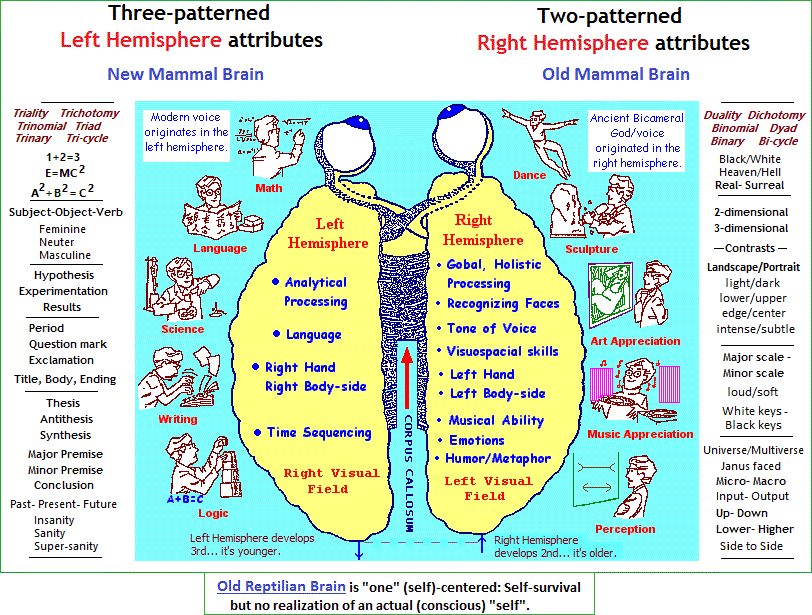
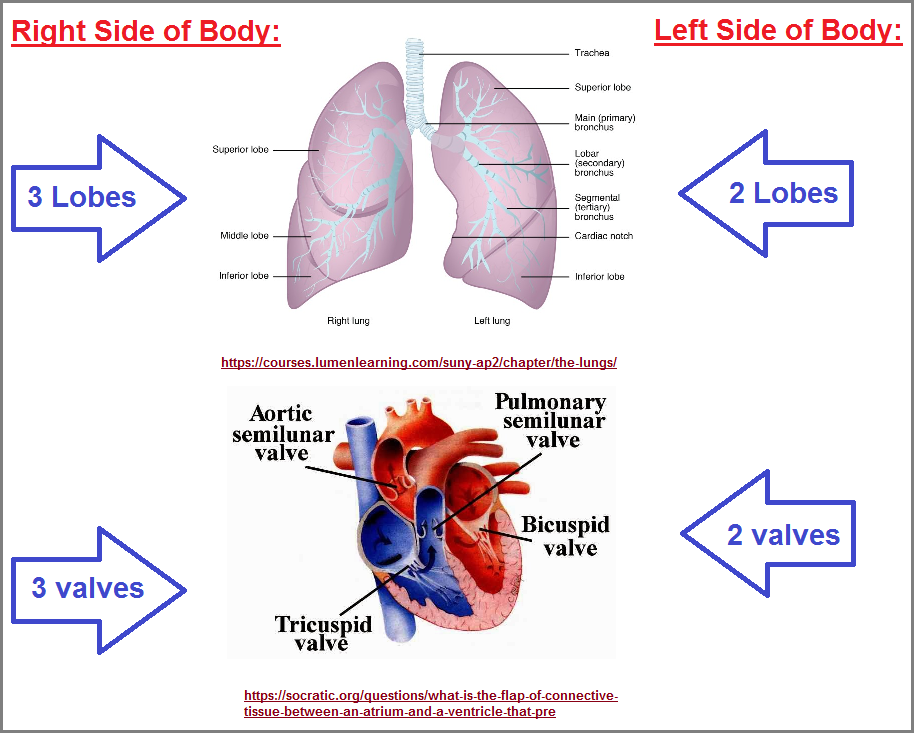
Anatomically, the lung has an apex, three borders, and three surfaces. The apex lies above the first rib. We should not overlook other three-patterned anatomical structures as well: Threes in Anatomy by Dr. McNulty and associates. In addition, for those who seem to be more interested in focusing on the 2 and 4 patterns of the heart, the fact that we can find a 2-3-4 ensemble of patterning of the heart and that the heart is referenced as a "pump" four chambers, correlating this pattern with other pumps such as those found in internal combustion engines, yields a 2, 3, 4 stroke variety. These can be seen here: Devil's Advocate page 14.
While many people may have encountered someone speaking of two characteristic heart sounds labeled as "Dub" and "Lub" (which one might humorously refer to as dot and dash), a third sound called a murmur, is sometimes referenced as that to be listened for during an examine. My heart exhibits the third sound which I have had as long as I can remember. Similarly, in Morse Code, a third sound which can be referenced as a 'space' is something one must listen for as well.
The three borders include the anterior, posterior, and inferior borders. The anterior border of the lung corresponds to the pleural reflection, and it creates a cardiac notch in the left lung. The cardiac notch is a concavity in the lung that forms to accommodate the heart. The inferior border is thin and separates the base of the lung from the costal surface. The posterior border is thick and extends from the C7 to the T10 vertebra, which is also from the apex of the lung to the inferior border.
The three surfaces of the lung include the costal, medial, and diaphragmatic surfaces. The costal surface is covered by the costal pleura and is along the sternum and ribs. It also joins the medial surface at the anterior and posterior borders and diaphragmatic surfaces at the inferior border. The medial surface is divided anteriorly and posteriorly. Anteriorly it is related to the sternum, and posteriorly it is related to the vertebra. The diaphragmatic surface (base) is concave and rests on the dome of the diaphragm; the right dome is also higher than the left dome because of the liver. (Anatomy, Thorax, Lungs by Raheel Chaudhry and Bruno Bordoni, Last Update: July 31, 2021)
Date of (series) Origination: Friday, 30th July, 2021... 6:38 AM
Date of Initial Posting (this page): Saturday, 22nd January, 2022... 11:49 AM
